#inspired by those medieval manuscript dragons
Text

Green Dragon (21 × 29.7 cm)
#art#dragon#washi tape#washi tape collage#washi tape art#artists on tumblr#mixed media#each scale is a carefully cut out tree#inspired by those medieval manuscript dragons#the sketch stage was actually really hard - i kept drawing shapes that made way too much anatomical sense LOL#ideally the body would be more compact but i went into this wanting to make a card with a front and back#so i stretched it out over the fold this way - tho this one didn't end up having a fold because i really wanted to do the scales this way#(i can't have pieces of washi tape going over the fold bc they'll start to let go)#i've been really excited to post this one!! i think it's one of the prettiest washi tape things i've made
11 notes
·
View notes
Text
Bestiaryposting Results: Slagzogg
This is, interestingly, our third consecutive Beaſt that's actually a common everyday animal pretty much all over Europe, including the area where this manuscript was produced. This is interesting to me because the three are handled very differently. First we had the salamander, which I'm pretty sure got mentally separated from the actual animal somewhere, probably because people use different terms for the real-life amphibian in different regions and languages, and not everybody is going to recognize that it's just the Greek word for the same animal. Second we had the deer, which it seemed like the manuscript producers did recognize, because the illustration is clearly a deer... but elements of the entry are just nuts (As @sweetlyfez said, "How do you make up this many wild myths about a guy you live with"). And now we have the [redacted until end of post], which is just given a completely mundane, if engaging, description with the only weird part being the symbolism attached to it.
I think it might also be our first domestic animal -- the entry even talks about the difference between wild and domestic varieties -- which seems like it's worth noting.
Anyway, as usual people who don't know what I'm talking about should check https://maniculum.tumblr.com/bestiaryposting. The entry this week's artists are working from can be found here:
This is another one where I almost didn't put it in because it seemed super obvious what it was, but the artists have done a superb job not drawing that. Excellent work on everyone's part, and it can be found below the cut:
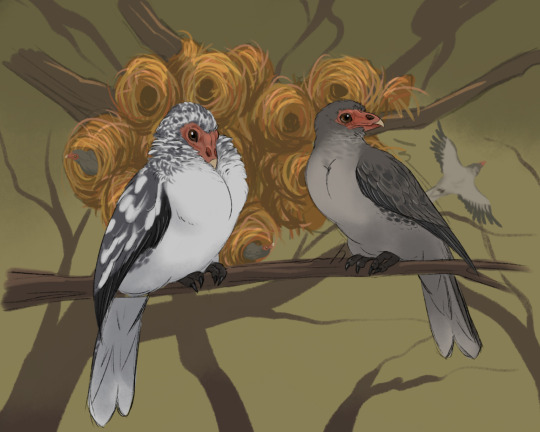
@silverhart-makes-art (link to post here) shows us both a domestic and a wild Slagzogg; the design of the domestic one makes me think of fancy pigeons, which I think is a pretty good direction to take here. The vulture-like faces really improve the design also. Very good birds, and you should go check out the linked post to hear about the design decisions and real-life inspirations behind this one; I think it's pretty interesting.
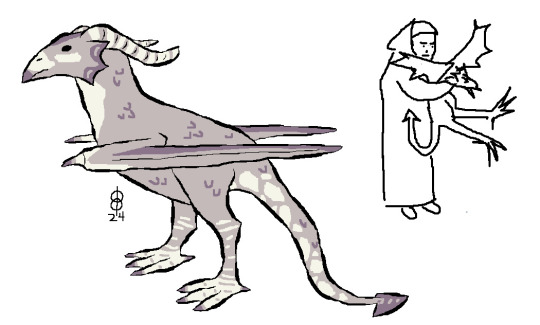
@pomrania (link to post here) observed that, though the entry mentions beaks and flight, it doesn't actually say "bird", so they can draw a pet dragon and have it fit the description. Fair call, and I think it turned out well. I like the contrast between the fairly dignified-looking creature on the left -- this is a Slagzogg who is on its way to win Best in Show -- and the sketch on the right of someone forcibly preventing it from getting into a fight. If you check out the linked post, you can see Pomrania's progress thread for this design.
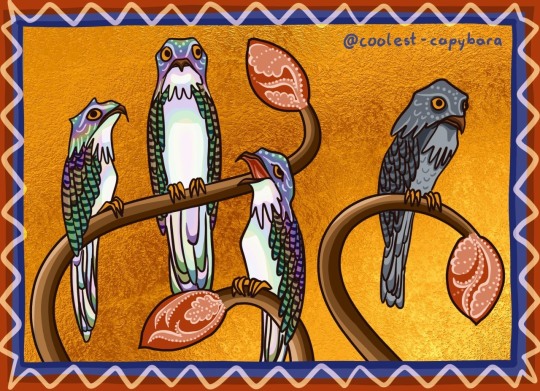
@coolest-capybara (link to post here) has made the eminently-understandable decision that if they're going to draw a bird with no specific anatomical details given, it's going to be a potoo. On the left we have three domestic Slagzoggs socializing, and on the right we have a wild one perching alone. I like how this incorporates the symbolism of the entry: we're told that the wild type is meant to signify people who choose a religious life ("those who keep apart from this world wear the modest garb of penitence"), and this wild Slagzogg does look a bit more serious and... monastic? Like, that bird is a nun. (Also, thank you for including alt text.)
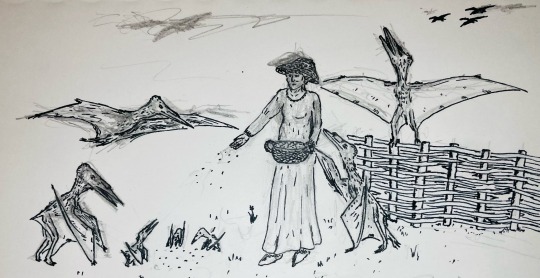
@cheapsweets (link to post here) also went with the direction of "well, it doesn't say 'bird'," and so we have this really charming image of a medieval person feeding their domestic... pterosaurs. Love it. Honestly, these alternate visions of the Middle Ages where people have entirely different domestic animals than our timeline are really appealing to me. Too much Dinotopia as a child, perhaps. Anyway, check out the linked post for substantially more detail, it's worth it. In fact, everyone reading this should just go ahead and follow all of the bestiaryposting participants. (Also, thank you for the alt text.)
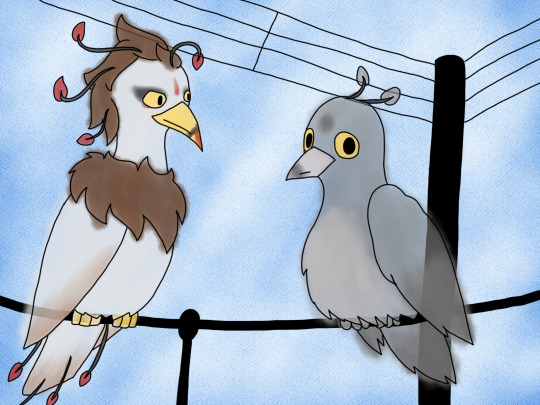
@strixcattus (link to post here) is clearly thinking of the modern day's feral pigeons, formerly the result of selective breeding by pigeon fanciers. We can see the "fancy" domestic version on the left contrasted with the wild version on the right. (I think it's interesting that everyone who's drawn both has put the domestic Slagzogg on the left and the wild Slagzogg on the right.) Anyway, as is usually the case with Strixcattus, the writing included in the post is absolutely worth your time and you should read it. And again, follow them, as well as everyone who has ever contributed to bestiaryposting. Go do it; you won't regret it.
Now, to the Aberdeen Bestiary.

Beak shape aside, these are clearly geese.
I think the degree to which people guessed that varies somewhat; Strixcattus made a post suggesting they were leaning "pigeon", but Pomrania probably clocked it, because they described two Slagzoggs fighting as a "hissing match" despite hissing not being mentioned in the entry. I have no idea where everyone else landed.
Honestly, what I find interesting about this entry is that it's pulling symbolism while remaining pretty much entirely grounded in reality. Check this out:
The goose marks the watches of the night by its constant cry.
Okay, I don't know to what degree it's useful in marking time, but I don't doubt that geese make noise at night.
No other creature picks up the scent of man as it does.
That one I'm not sure about.
This next bit I cut because if anyone knows Roman history they'd nail it right out of the gate:
It was because of its noise, that the Gauls were detected when they ascended the Capitol. Rabanus says in this context: 'The goose can signify men who are prudent and look out for their own safety.'
Okay, that might be less history and more legend, but still, people know it, I think.
There are two kinds of geese, domestic and wild. Wild geese fly high, in a an orderly fashion, signifying those who, far away from earthly things, preserve a rule of virtuous conduct.
I can absolutely see medieval people looking up at geese flying in that V formation and going, "look how orderly these birds are; clearly they are virtuous creatures."
Domestic geese live together in villages, they cackle together all the time and rend each other with their beaks...
Yeah, that sounds like what geese would do in a village.
All wild geese are grey in colour; I have not seen any that were of mixed colour or white. But among domestic geese, there are not only grey but variegated and white ones. Wild geese are the colour of ashes, that is to say, those who keep apart from this world wear the modest garb of penitence.
This bit falls into the category of "I believe it, but it does not accord with my personal experience." Because if you told me that in Europe they had a variety of different aesthetically-pleasing domestic goose breeds, I'd have no problem believing that. And I'm sure some wild geese are gray. But I live in North America, so to me wild geese look like this:

And domestic geese look like this:
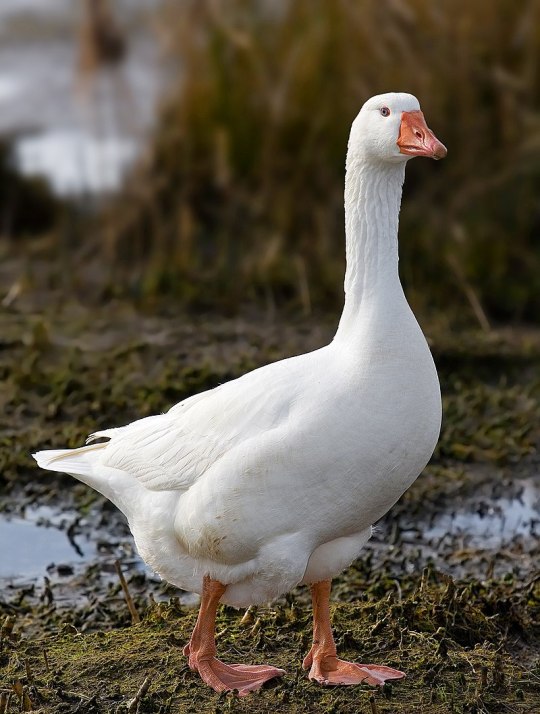
But again, I have no difficulty believing that the experience of the medieval Europeans was different from mine.
What really sticks out to me here is the fact that the characteristic behavior of domestic geese is to make noise and get in fights -- I think the Untitled Goose Game would have made perfect sense to a medieval audience.
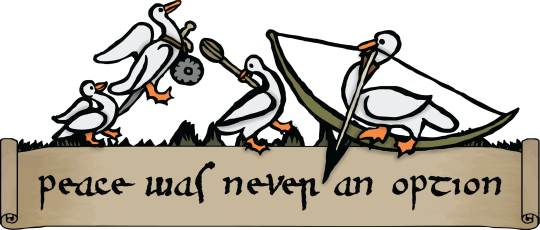
(After the Smithfield Decretals)
53 notes
·
View notes
Text

The exact origin of the Kol Nidre melody is a bit of a mystery…
It's been claimed that the melody's roots can be found in German medieval folk music. Others have rejected this idea, arguing that it is clearly of Jewish origin.
There is, in fact, not just one Kol Nidre melody, but a collection of musical themes which came together and settled in a permanent order at some point during the 15th or 16th centuries.
The combination of the religious setting, the emotional backdrop, and the powerful melody creates a unique psychological atmosphere among those gathered to hear the prayer on Yom Kippur.
Much of this has to do with the ability of music to reach into the soul, even if the listener cannot understand the words. A few notes are often enough to trigger intense feelings and bring back old memories.
Over the centuries, the Kol Nidre melody has inspired countless musicians and artists, from classical composers to filmmakers to psychedelic rock bands.
See the first comment below to read on…
#YomKippur
The image below, an initial-word panel for the Kol Nidre prayer featuring decorative dragons and mythical beasts, appears in a Hebrew illuminated manuscript made in Germany in the early 14th century. It can be found at Oxford's Bodleian Library (MS. Mich. 619, fol. 100), zoom in here
National Library of Israel
37 notes
·
View notes
Note
Hey so for your hs au, we're the kids always big dragon things or did they become dragon things at some point via wacky sburb shit? Love the designs they are so cool
Thank you so much!!
The au was inspired by some posts I saw (can’t find them now 😔) that were essentially just talking about how cruel SBURB is, and it got me thinkin a bit.
At this point I’d already had the idea “hey what if godtier let them turn into big monsters” because, and you may notice a theme here, I really like big monsters. There was no lore at all at that point. They literally just. Were big monsters. For fun!
But I got thinking about it more, and kind of came to this conclusion:
Godtiering steals your life, your very humanity from you. It makes you a god, by definition. What if that was very literal?
So the au is everyone starts out like normal, but once you godtier things start to get weird. It starts small, a single pair of wings (which, ironically they don’t actually use to fly. They could, but they still have their floaty godtier powers (and honestly there’s a whole lot of lore around THAT too)). The more you use your godtiering powers and the more time you spend as a god, the less you really… fit inside a human/troll/etc. shape, anymore, and the more your body starts to morph into something larger and grander. Something more befitting of those who have mastered the game.
And that’s basically it, that’s the only way this au diverges from canon. It’s essentially a re-skin of an au lmao
I will say the gods can return to a human shape, but only visually and it’s difficult. They sort of come to embody their aspects - literally - so if they can figure out a way to condense or conceal their aspect, they can in turn condense themselves to be something smaller. Like I said, it’s tricky though. It’s probably something they would’ve only figured out post-canon. That, and it’s something they have to consciously maintain. If they don’t, the rest of them starts to “bleed through” back into visible reality in weird ways. Since it’s all tailored to their aspect it looks different for each of them. I want to draw Dave bleeding through sometime because I have a really cool idea for what it would look like for him.
One last thing, more of a design note than anything. I actually… don’t really like their designs yet. Well, I guess it’s more that they’re not really what I want yet? I do like some of them (especially Dave’s, Dave might not need any revisions actually). While designing them I really want to model them after two concepts:
1. Illuminated manuscripts and heraldic beasts, because the classes are based off of medieval fantasy and I think it’d be sick to reference that.
2. Eldritch/cosmic horror, because that more than anything emphasizes that they don’t really belong in any one universe anymore, and also emphasizes their loss of mortality and thus, in a way, life.
I feel like most of them lean too far towards either one, and aren’t balanced between them like I want. Hence why I’m unsatisfied with them atm! I am very glad you like them though :)
10 notes
·
View notes
Text

The exact origin of the Kol Nidre melody is a bit of a mystery…
It's been claimed that the melody's roots can be found in German medieval folk music. Others have rejected this idea, arguing that it is clearly of Jewish origin.
There is, in fact, not just one Kol Nidre melody, but a collection of musical themes which came together and settled in a permanent order at some point during the 15th or 16th centuries.
The combination of the religious setting, the emotional backdrop, and the powerful melody creates a unique psychological atmosphere among those gathered to hear the prayer on Yom Kippur.
Much of this has to do with the ability of music to reach into the soul, even if the listener cannot understand the words. A few notes are often enough to trigger intense feelings and bring back old memories.
Over the centuries, the Kol Nidre melody has inspired countless musicians and artists, from classical composers to filmmakers to psychedelic rock bands.
See the first comment below to read on…
#YomKippur
The image below, an initial-word panel for the Kol Nidre prayer featuring decorative dragons and mythical beasts, appears in a Hebrew illuminated manuscript made in Germany in the early 14th century. It can be found at Oxford's Bodleian Library (MS. Mich. 619, fol. 100), zoom in here
National Library of Israel
17 notes
·
View notes
Text
Medieval History AU
for @carryonthroughtheages
For my piece for the medieval era, I took inspiration from illuminated manuscripts.

(Please click the image for better quality.)
Read more about the piece below the break.
I want to first say a huge thank you to @bazzybelle for organizing this event and also for just being a really great human. ILY! Despite the fact that I of course left everything to the last minute, I have had a blast working on my two posts and can’t wait until I have time to actually look at what everyone else has done.
About the artwork:
This is a haphazardly researched piece at best.
I initially planned to simply do a group drawing, showing the gang dressed appropriately for their places in my medieval AU. I had that sketch sitting around for months and never felt inspired. Then I started to think about how I could adapt my arsenal of art supplies to give the effect of something more suited to the time periods. And then I thought about a lovely comment that someone made on one of my drawings, that it reminded them of an illuminated manuscript. And then the book art nerd in me was activated. Thus, I spent the next week pulling references from various illuminated manuscripts that have made it online in some form or another over the years. Next came the design. I wanted to find a way to still include the whole group, but a simple line-up no longer made sense. I wanted to make SnowBaz the focal point, for obvious reasons, but I found a way to include the others in insets, as some full page illuminated manuscripts depicted smaller scenes around a central idea.
I knew that I had to include at least one dragon for Simon and somehow reference Baz's vampirism. Monsters appear all over illuminated manuscripts, after all, and I saw no reason why they shouldn't be in mine. Vampires in medieval folklore were different to the way we think of them now; they weren't living people who turned into blood drinking creatures, but rather reanimated corpses. These revenants are usually depicted as some variation on a rotting corpse or skeleton. I decided to stick with our modern understanding of vampirism, because I'm not wholly sold on the zombie thing. A skull and some rats chilling around it probably gets the point across, and ties in Baz's years in the Catacombs, which definitely still exist in this AU. Also, I see medieval Baz as a minor feudal lord of some kind, which plays into the classic vampire metaphor. Simon is a former knight errant who gave up his questing days once he faced the reality that perhaps he wasn't all that different from the monsters he hunted.
The vessel at their feet, which sits over flames, is a crucible. Because of course I was going to include a crucible in my medieval AU. The crucible is an ongoing metaphor in Simon and Baz's story, and I wanted to carry that motif into my piece, too. I based the shape off a couple different depictions I found that related specifically to alchemy. Alchemy is all about transmutation, rather fitting for two half monsters who continuously challenge the roles they've been assigned. (One of the crucible drawings I found even had a tiny dragon looking down the spout and blowing fire into the vessel!)
The alchemy theme continues to the top right corner, with a green lion eating the sun. This is a very common image in alchemical texts, a metaphor for vitriol purifying matter, which would then leave behind gold. Next to the green lion is Agatha, who finds far more to interest her in making friends with unicorns than in the attentions of any courtly suitors. The larger panel in the center shows the castle, the hub of medieval life, inspired by the look of Watford as depicted in the map at the end of Carry On. This version of Watford is also protected by a moat filled with merwolves, because they are exactly the sort of unholy beast that would appear in the marginalia of an illuminated manuscript. (Maybe the Mage got the idea of the merwolves from one of the "four-hundred-year-old texts" he dripped gravy on.) Stars fill the sky, because we all know how important those are. On the castle's other side is Penelope, bent over a parchment in a room filled with thick books, living her best scholarly life, now that she's retired from life as Simon's shield bearer. She and Shepard are both modeling the latest trend in eyeglasses, which is to say, the only trend, because that was cutting edge technology back in the day. (Would either one of them have had access to that kind of fancy tech in their respective positions? Idk, but they have unicorns, and flying sheep, and merwolves, and dragons, so let them see is all I'm saying.) Shepard is, if you couldn't guess, a shepherd, because I had to. But he's still a nomad at heart, and this new flock was acquired in a rather secretive deal during his last adventure. Lastly, the slogans on either side of Simon and Baz are the Google Translate Latin equivalents of: "Magic separates us from the world. Let nothing separate us from each other" and "Light a match inside your heart, then blow on the tinder." (If you can actually read my writing, and you actually know Latin, and these aren't correct, just pretend that they are.)
Illuminated manuscripts were usually embellished with gold leaf, and my budget version is metallic gold marker, which I used sparingly throughout the piece for fire and other objects of note (though it's probably hard to see in the scan).
That's all, I think. Thanks for coming to my Ted Talk!
Bonus! Process shots;

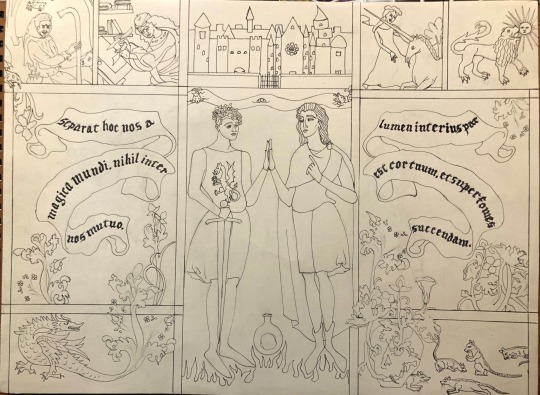
#cotta2020#carry on through the ages#my art#medieval au#formerly known as#joust do it#simon snow#baz pitch#tyrannus basilton grimm pitch#snowbaz#penelope bunce#penny bunce#agatha wellbelove#shepard#from omaha#random mentions of alchemy#process photos#carry on fan art#simon snow fan art#simon snow series#carry on#wayward son#any way the wind blows#co/ws/awtwb#co/ws#awtwb#rainbow rowell
207 notes
·
View notes
Text
Observations on the Hierarchy Of the Guard of Priwen
The Guard of Priwen largely remains a mystery to us as the player throughout Vampyr. No matter how openly we see them patrol the streets as some form of underground night watch, we only see glimpses of their true, and supposedly resurrected power, let alone witness the history of what they were before the schism from their “cowardly” brothers, the Brotherhood of St. Paul’s Stole. As Lady Ashbury parts with us, the Guard of Priwen is a secret society, one of many in the dreary and eerie vampire underworld.
I have other plans to delve deeper into the militaristic madness that is the Guard of Priwen’s inner workings and possible historical backgrounds, but I first wanted to share this small piece regarding the one detail that is most obvious in the game: the several Mobs we encounter with their logos splattered all across it. Therefore, this will be a shorter analysis solely dedicated to the possible hierarchy within Priwen, combining datamined research, the lore, and some fun historical notes behind each and every rank!
As per usual, this analysis will have spoilers, this time all the way through! All parts of this post will discuss Vampyr’s lore in detail, so please skip if you do not wish to be spoiled!
Tagging @comfycheesecakes, @orionali, @cursedbethechoice as I imagine some of this may be to each of your interests.
To preface a starting point point: Usher elaborates on the history of Priwen’s conception when Jonathan speaks to him in the West End inside his crypt:





Usher also writes of them in the Collectible “Laughing at the Guard”, explaining their origins and beliefs from a historical point. The Collectible helps to detail the inner turmoils that founded the Brotherhood as well as the detailed purpose behind its creation:
Full screenshot
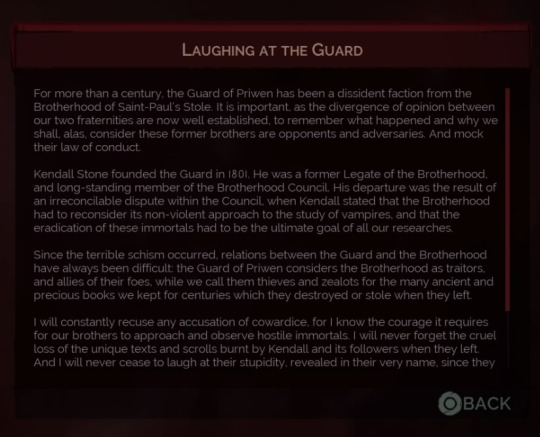
Full screenshot

This gives us a starting point to Priwen’s possible background and development. 1801 places the birth of the Guard of Priwen in the Georgian Era, beginning from 1714 to circa 1830 - 1837.
You will also see a militant trend following Priwen which is also an obvious fact in game but characters like Archer Woodbead in The Docks or Dorothy Crane in Whitechapel, both in Districts with the highest concentration of Priwen, this is a very visible trend for those around them:


Dorothy’s exchange occurs if you Spare her as Jonathan, revealing a harrowing fact about Priwen’s encroaching behaviour in their fanatical fear of keeping any sign of vampire activity eradicated. Beforehand, Priwen guards burst in to the Dispensary regardless of your Pillar Choice as Jonathan, with the patients downstairs being shot to death should you check again with Senses. The bodies no longer have visible heartbeats.



When Jonathan begins to gain access to the rich streets of the West End, it, too, struggles to avoid Priwen’s influence with not only their guard presence, but also their criminal presence!
Inspector Charles Jerome Albright will speak to Jonathan about the recent happenings and murders in London, claiming that there are:

Jonathan has the option to then report a possible suspect, one of these being Geoffrey McCullum, the current leader of Priwen:

If you choose McCullum, Jonathan calls Priwen a group of “vigilantes”; a vigilante is someone, or a group, who attempts to enforce laws (or their ideas of what is law) without the authority to do so.


With this very worrying trend now established, let us fully move onto dissecting Priwen’s inner workings!
GUARD OF PRIWEN
What’s interesting to note is that a lot of the current enemies in GoP have different names depending on where you look—from either the canonical versions in the game themselves, to the game files, or even the concept art. I will be looking at all three sources for any comparisons!
PRIWEN
To begin dissection—I will first begin with the titular names of each organisation for each of their respective sections, beginning with the Guard of Priwen. “Priwen” is a reference to Geoffrey of Monmouth’s (Latin: Galfridus Monemutensis, Galfridus Arturus, Welsh: Gruffudd ap Arthur, Sieffre o Fynwy) Arthurian legend titled “The History of the Kings of Britain”, or “De gestis Britonum” (On the Deeds of the Britons) or Historia regum Britanniae”, written circa. 1136.“Priwen” is the name of King Arthur’s shield, hence, the Guard of Priwen:
“Without a moment’s delay each man present, inspired by the benediction given by this holy man, rushed to put on his armour and to obey Dubricius’ orders. Arthur himself put on a leather jerkin worthy of so great a king. On his head he put a golden helmet, with a crest carved in the shape of a dragon; and across his shoulders a circular shield called Priwen, on which there was painted a likeness of the Blessed Mary, Mother of God, which forced him to be thinking perpetually of her.” — Legends of Arthur, Richard Barber, 2003.
Arthurian myth utilized in several aspects of Vampyr, with this being one of the more prominent examples. The symbol of Priwen is also referencing this myth, as it resembles a Latin cross with a circle to represent a shield:
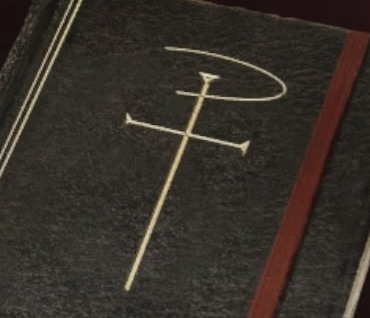
LEADER
This is relatively standard, but we do know that the head of the Guard of Priwen is always referred to as “leader”, as the notes done by Geoffrey McCullum and Carl Eldritch thus far are denoted by “leader”; the only exception is reserved for Kendall Stone who is also denoted as “Founder”. “Leader” is rather self-explanatory, as it simply means “someone who leads a group”. Interestingly, it also seems to be used for those who are not the head of Priwen either, as we see in the scouting note during Thelma’s side-quest: a female “team leader” who went by Amanda Tilton. This seems to indicate there is no specific or official title to discern the head of Priwen, perchance making “leader” more of slang or casual terminology that merely stuck through the generations. The below are either written manuscripts by the leaders themselves, or copies from another.
Full screenshot

Kendall Stone’s denotation and signature:
Full screenshot


Carl Eldritch’s denotation and signature:
Full screenshot


Geoffrey McCullum’s denotation and signature:
Full screenshot


CHAPLAIN/SHEPHERD/PREACHER
(For the purpose of relevancy, I will mostly be focusing on the Chaplain terminology as that is the canonical one we see in-game, but will still be examining the Chaplain’s alternative terms and their origins.)
Chaplains are curious. You do not see them until much later in the game (other than certain exceptions regarding side-quests), there are two versions of them according to the game files, that being the Shepherd_Preacher and the Shepherd_Fanatic, but only one model, the Fanatic, remains in the game. Shepherd_Preacher is the first version of the Chaplain which we see in the E3 2017 Trailer. Their enemy busts are below; the model shown in the game files is only of the Fanatic:

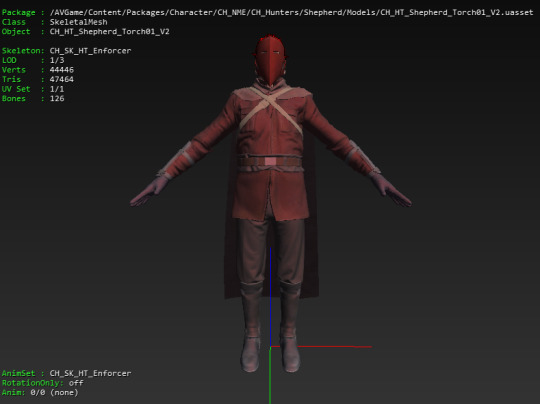



Concept art also reveals them being originally labelled as “Preacher”, with a single exception being that sometimes, the loading screen within the game will use the title:

Florent Auguy
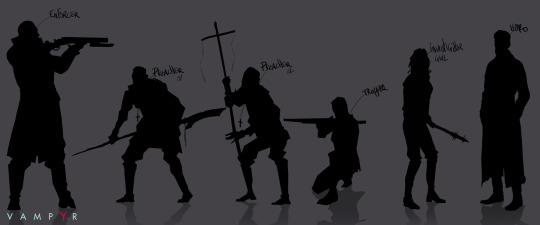
The word “chaplain” is borrowed from Old French “chapelain”, which in-turn stems from the Medieval-to-late Latin “cappellānus” that also hails from a Medieval Latin to Late Latin word read as “cappella”. Notably, “cappella” is defined as a chapel or a choir. The story of chaplains themselves hail from a 4th-century practice:
In the 4th century, chaplains (Latin cappellani) were so called because they kept St. Martin’s famous half cape (cappella, diminutive of cappa). This sacred relic gave its name to the tent and later to the simple oratory or chapel where it was preserved. To it were added other relics that were guarded by chaplains appointed by the king during the Merovingian and Carolingian periods, and particularly during the reign of Charlemagne, who appointed clerical ministers (capellani) who lived within the royal palace. In addition to their primary duty of guarding the sacred relics, they also said mass for the king on feast days, worked in conjunction with the royal notaries, and wrote any documents the king required of them. In their duties chaplains thus gradually became more identified with direct service to the monarch as advisers in both ecclesiastical and secular matters.
In modern usage, a chaplain holds a strange position within the religious circle they reside in, most notably because the definition of a “chaplain” is a cleric who is assigned to a secular institution such as a hospital, prison, military forces, universities, and so on.
n. A member of a religious body (often, but not always, of the clergy) officially assigned to give pastoral care at an institution, group, private chapel, etc.
A person without religious affiliation who carries out similar duties in a secular context.
…
Clergy and ministers appointed to a variety of institutions and corporate bodies—such as cemeteries, prisons, hospitals, schools, colleges, universities, embassies, legations, and armed forces—usually are called chaplains.
Often they are considered a religious leader or some form of a figurehead, with some chaplains previously being leaders of a chapel before their assignment to a different institution. Given Priwen’s circumstance of being an underground militia, the usage of the word makes perfect sense as the Chaplains of Priwen seem to hold the same responsibilities of real-life, in this case, military chaplains (as they are called) who serve in the armed forces (the concept of allowing religious figures into battle, to this day, still holds much controversy), or we can at least assume they do some of the following which are:
A chaplain performs basically the same functions in most armed forces. A chaplain in the U.S. military must furnish or arrange for religious services and ministrations, advise his commander and fellow staff officers on matters pertaining to religion and morality, administer a comprehensive program of religious education, serve as counselor and friend to the personnel of the command, and conduct instruction classes in the moral guidance program of his service.
Beyond that, a “shepherd” has a variety of religious messages but to keep it short: “shepherd” stems from the Middle English word “schepherde” to the Old English “sċēaphierde” which is a mixture of the two words “sċēap” (”sheep”) and “hierde” (”herdsman”). A female version of the word is a “shepherdess”. The word itself has multiple sorts of definitions, with a rather funny one to think about at times:
n.
A person who tends sheep, especially a grazing flock.
(figuratively) Someone who watches over, looks after, or guides somebody.
(figuratively) The pastor of a church; one who guides others in religion.
(poetic) A swain (”young man”); a rustic male lover.
A “preacher” is as it sounds: someone who spreads their worldview or philosophy. In this case, it would be perhaps a gospel or a sermon. From the Old French “preecheor” (”prêcheur”), to Latin “praedicator” (”public praiser”, “proclaimer”). A female preacher is known as a “preacheress”.
EXECUTIONER/TRAPPER
Executioners, or Trappers as the concept art referred them as (see above), are the crossbow snipers wearing red, hooded garbs, able to throw gas grenades and flaming bolts, bereft of any melee resistance whatsoever. According to the game files, there are three types of Executioners. Here are the files:

Alongside their respective busts labelled Chemical, Fire, and Wood, their models are instead labelled CrossBow, FireCrossbow, and Sniper:





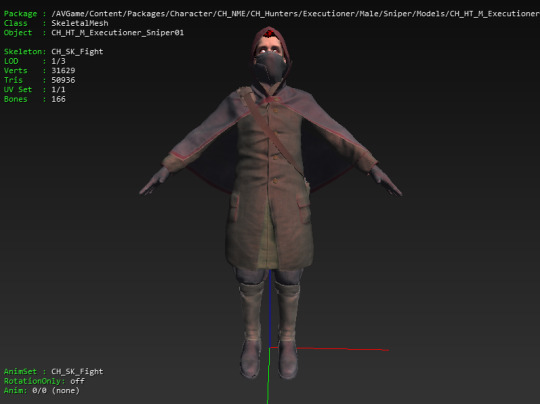




The word “executioner” is a combination of the words “execution” , which is borrowed from Old French “exécution” (c. 1360) of the Latin “executio”, an agent noun (a word deriving from another word that denotes an action of some sort), of “exequi” (”to follow out”) which stems from “ex” (out) and “sequor” (”follow”) and of course, “-er”, from Middle English “-er” and “-ere”, as well as Old English “-ere”, and Proto-Germanic “-ārijaz” used as a suffix. “Executioner” is also a fairly self-explanatory definition; it literally means “one who executes”, but to ensure that we are being thorough:
n
An official person who carries out the capital punishment of a criminal.
(archaic) Executor (one who conducts a task).
A hit man, especially being in some organization.
An “executioner” was historically seen as a “hangman” or “headsman”—a reference to the practice of execution via. means of public decapitation. This, alongside the file name of “Sniper”; the fact that the Executioner is only ranged, defined as “hit man, especially being in some organization” and that beheading would often result in instantaneous death, the choice of title is very distinct. Like beheadings, a sniper aims to kill with a single action—an underleveled Jonathan will easily be one-shot by an Executioner from afar, making their name strikingly fitting. The fact that they are a part of Priwen, an “organization” of sorts that specializes in executions of the undead, is simply a fond, bloody coincidence.
In comparison, a “trapper” is, well, one who “traps” something, often animals for their hides or other precious materials. This may be an insinuation that literal traps of some kind were going to be added to the final product but were inevitably cut out. It does, however, fit Priwen’s perception of vampires—that they are feral animals to entrap and be rid of.
INVESTIGATOR
This will be short, as it is a term used in the game files and concept art for three ranks od Priwen, which happen to be the most squishy of mobs: Priwen Rookies (Rookie), Priwen Cadets (Veteran), and Priwen Gunners (Range).

“Investigator” is also self-explanatory: “one who investigates”, which is to say:
v.
(transitive) To inquire into or study in order to ascertain facts or information.
to investigate the causes of natural phenomena
(transitive) To examine, look into, or scrutinize in order to discover something hidden or secret.
to investigate an unsolved murder
(intransitive) To conduct an inquiry or examination.
Said to have derived from the mid-1500s, from Latin “investigator” which hails from “investigare”. Interestingly, we know that female versions of each of these models exist in the game files apart from NPCs, confirmation of a female “leader” as shown above, as well as hearing female voices in the Prologue of Vampyr when Jonathan must escape the mass grave at dawn. Women were shown in the Alpha iterations of the game. Elwood confirms the presence of women in Priwen if you speak to him soon after Edgar’s kidnapping:

The feminine usage of this word is known as “investigatrix”, from Latin “investīgātrix”.
ROOKIE
Rookies are the most numerous types of enemies within the game as well as the first one you encounter within the Prologue. They only use melee weapons and hold resistance to Ranged Attacks. The sheer amount of them you find are most likely a reference to the Guard’s revitalized state in the wake of the Skal Epidemic. Ashbury mentions that Priwen was “almost gone” before Priwen began its new wave of mass recruitments:


Jonathan will frequently hear references to this mass recruitment when wandering around idle Guards:

“Rookie” is also a rather simple word to dissect: an altering of the word “recruit” and “-ie”. There is also a possibly Dutch origin from the word “broekie”, short for “broekvent”, lit. meaning “a boy still in short trousers”, which explains why “rookie” is often used as a sort teasing term. To be technical:
n. plural “rookies”
An inexperienced recruit, especially in the police or armed forces.
A novice.
As the first definition shows, it does have some bearing to Priwen’s overall trend of having a nomenclature relating to militaristic forces.
The Rookie’s respective enemy UI portrait and model:




CADETS/VETERANS
Cadets, or Veterans as the game files name them, are essentially Rookies with guns or flaming torches, only being somewhat tougher than fresh-blooded Rookies. This can be inferred as a progression in rank—a Rookie that’s survived their first couple of nights on patrol. They certainly look more well-garbed, and the term “veteran” also fits with this idea of experience alongside surviving the dreary, vampiric-ridden streets.
The Cadet’s enemy UI and model:

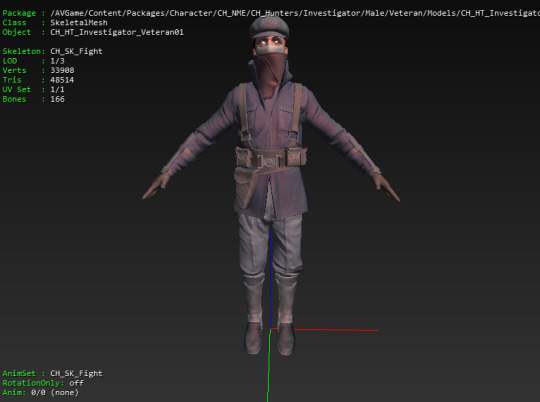


An interesting feature to note at this point about each of Priwen’s enemies is that the majority of them seem to have an undercut. At the time (and even now), undercuts were done on men deployed to the war as the militaristic style of the era—Jonathan and McCullum share ones of their own. This hints to Priwen’s military connections that many NPCs remark on (as shown above) and that some of Priwen’s members do hail from military backgrounds which are demonstrated in their extreme firepower and access to various parts of the city.
“Cadet” stems from French “cadet” from a southwestern French known as Gascon Occitan “capdet”, further back into the Late Latin “capitellum” (”headling”) shortened version of “caput” (”head”), sharing English form by 1634. “Cadet”, unsurprisingly, is also a term with military usage. The female version would be spelt “cadette”. It also holds a definition for “junior”:
n. plural cadets
A student at a military school who is training to be an officer.
(largely historical) A younger or youngest son, who would not inherit as a firstborn son would.
(in compounds, chiefly in genealogy) Junior. (See also the heraldic term cadency.)
a cadet branch of the family
“Veteran” is borrowed from Middle French “vétéran”, of Late or Vulgar Latin “veterānus” of the word “vetus” (”old” or “aged”). It is a rather official word referencing one who has served in the military or armed forces, most specific to older soldiers or those who have seen long years of service. While the age of Priwen’s Guards can certainly be up for debate—Cadets, while relatively squishy, seem to be what Rookies advance to should they survive their first nights at the mercy of patrols, facing whatever awaits them during it.
GUNNER
Gunners are another frequent, early mob of Priwen that you encounter. They are about as numerous as Rookies and equal in their frailty, only they seem to be Rookies with more additions to their design and opt to only use Ranged Attacks, much like their fellow Executioners. The portrait shows no difference as it is a reused UI bust, but their outfits differ slightly.

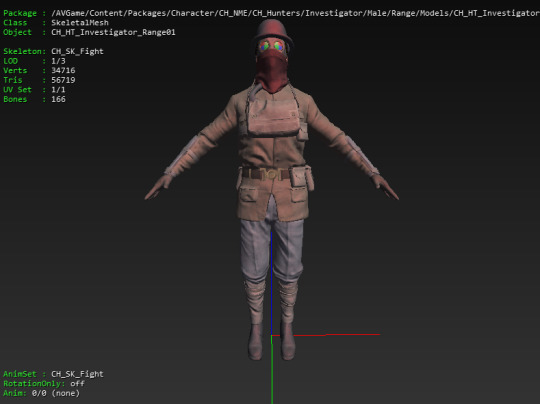

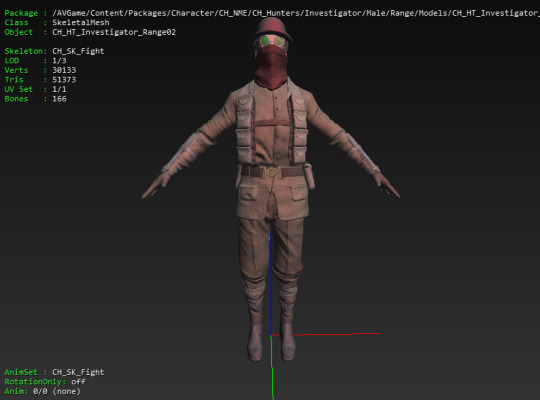


“Gunner” sounds straightforward but does hold a military usage. One can literally define “gunner” as “someone who uses a gun”, but the word itself is a rank used in the British Army Royal Artillery. It is abbreviated as “Gnr”, and is equivalent to the military rank of a “Private”, which makes sense. They hold similar stats to Rookies, Rookies are stated to essentially be new recruits—privates usually act as the lowest, entry-level rank in the military after training has completed, which means that Gunners, too, are on par with Rookies in terms of Priwen’s hierarchy.
BRAWLER/ENFORCER
Brawlers are quite the mixed bag of things. There are three different variations of them in the game files, are seen relatively early in the game, and serve as the brutish powerhouses Jonathan has to face when running into more of Priwen’s hordes. We seem them with heavy guns, a shield on their left arm, gas, and flames. A wide assortment of anti-vampire materials is cast onto a single kind of member, which proves interesting.
In the game files, they are known as Enforcers with three names: Flamer, Ram, and Shield (”Tank” seems to be used generally amongst all of them for clothing files).





“Brawlers” is defined as “one who brawls”, which is to say: “fight or quarrel”—of Middle English “braule” and “brall” (”brawl, squabble”) of earlier “braulen” and “brallen” (”to clamour, boast, quarrel”). Similar words from Middle High German (”prālen”; “to boast, flaunt”)), Low German (”brallen”; “to brag”), Dutch (”brallen”; “to boast”), and Danish (”bralle”; “chatter, jabber”) have also been considered, whose meanings make sense. Priwen’s guards hold no shortage of leech-related insults, but the Brawlers have quite the large assortment of them out of every other Guard member. A show of their imposing sizes and statures, I would wager. However, their large array of weapons, brute force, and usage of miniature bosses imply that Brawlers are quite high on the ranking list. Chaplains are the only thing larger than them, and it has been established that Chaplains are sort of seen as pious, leading figures. Consider this when taking a look at the game files term for Brawlers: Enforcers.
“Enforcers” is a combination of “enforce” and “-er”, with “enforce” coming from Old French “enforcier”, of the Late Latin “infortiāre”, from “in-” and “fortis” ((physically)“strong”)). I emphasize this word for the Brawler for one definition in particular:
n.
One who enforces.
The member of a group, especially of a gang, charged with keeping dissident members obedient.
Ram is also a reference to a battering ram (and the ability in which they charge at you) used in the British Police Forces. The second definition is specific to a Mob Enforcer. Priwen has access to multiple parts of London, with heavy access to firepower, large numbers, and seemingly free reign once night comes, kept entirely away from law enforcement. This is what discerns Priwen from a gang per say—their power and influence put them upwards to that of a Mob, or a “traditional gang” which is essentially a gang with overarching influence upon a region, to the point that they nearly act as the local law enforcement. Multiple mobs/traditional gangs existed, some of notable fame, throughout the Victorian Era well into the World Wars, many of which centred in the East End much like Priwen is: Peaky Blinders, Birmingham Boys, the “Sabini” gang, Hoxton Gang, The Yiddishers, and several others.
Brawlers essentially being Mob Enforcers must mean they hold a lot of trust within Priwen to both be given the position of watching the other men, as well as proving they can also follow through with said position.
With all of what we know of Priwen now defined, here is a chart of what I believe to be the hierarchical structure within the Guard of Priwen from what we have gathered:
Full image

As Ashbury says: like all good societies, Priwen is still very much a secretive one even with such open recruitment. There may be inner workings we are unaware of, and what we have been revealed to may only be scratching the surface of what truly hides within the esoteric, fanatic-hunting organised Mob that Priwen has built itself into. Worse more is the mystery behind their schism with the Brotherhood: a once united group, now a duality that remains incessantly at odds. The way the current Brotherhood organises themselves is much more esoteric and theological than that of militaristic Priwen, a further representation of their dichotomy being at odds.
CREDITS:
None of this data collection would have been possible without the informative help of @wolfsirius and @orionali. Of course, I will never write a post without thanking @cursedbethechoice for their initial, contributive works to the lore of this fandom and for continuing to inspire me throughout.
The tool I used to view these files was from Gildor’s Umodel Viewer.
EXTRA COMMENTS:
This essay is exactly 3,724 words long!
It’s been quite a long while since I’ve written anything despite being active on the blog. Nearly a year now! I’m hoping this small introduction allows me to ease my way back to the projects I wanted to share (which are a lot) both here in full, and show peeks of on Twitter! Thank you to those who have continued to follow this blog despite the time gap. I hope to be much more frequent with Lore posts here!
You may notice a tag at the bottom labeled “secret societies series”. That is because I intend to have a small series of analyses dedicated to the three major factions we witness in Vampyr: The Guard of Priwen, The Brotherhood of St. Paul’s Stole, and The Ascalon Club. This will be the catch-all tag for any analyses relating to those topics! …With a possible mention of the Druid Order (mentioned in the “Blood Goddess Heresy” Collectible).
Other “series” are still in the works!
Full screenshot
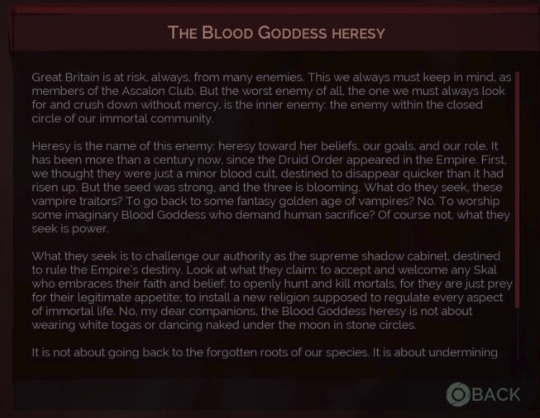
Full screenshot

ALL SOURCES/BIBLIOGRAPHY (in no particular order):
Legends of Arthur, Richard Barber, 2003
“GANGS”, Bill Sanders, February 2016 — Oxford University Press
Chaplain, ENCYCLOPÆDIA BRITANNICA
Oxford English Dictionary
Merriam-Webster’s Online Dictionary
Wiktionary
Online Etymology Dictionary
The British Army Website’s British Army Structure
London Metropolitan Police’s Article of the Enforcer
Wikivisually’s Article on the Enforcer (battering ram)
Etymology of “Chaplain” – Traditional & Professional, Rev. Dr. Michael G. Maness, 1998, revised 2015, formerly published as “Meaning of Chaplaincy”
The etymology of “rookie” in Wikitionary
The etymology of “chaplain” in Wikitionary
The etymology of “brawl” in Wikitionary
The etymology of “enforce” in Wikitionary
Online Etymology’s Dictionary’s Page on “enforce”
The Mob Museum in Las Vegas—National Museum of Organized Crime & Law Enforcement
Online Etymology’s Dictionary’s Page on “veteran”
Online Etymology’s Dictionary’s Page on “shepherd”
Online Etymology’s Dictionary’s Page on “preacher”
The etymology of “shepherd” in Wikitionary.
“investigate” in The Century Dictionary, The Century Co., New York, 1911
“investigate” in Webster’s Revised Unabridged Dictionary, G. & C. Merriam, 1913
King Arthur: The Mystery Unravelled By Chris Barber
Journey to Avalon: The Final Discovery of King Arthur By Chris Barber, David Pykitt
The Welsh Academy Encyclopædia of Wales. John Davies, Nigel Jenkins, Menna Baines and Peredur Lynch (2008) pg. 668
#vampyr#vampyr game#guard of priwen#dontnod#essay#secret societies series#it's been a while#good to be back!#mine
71 notes
·
View notes
Text
Lore Episode 130: In Plain Sight (Transcript) - 25th November 2019
tw: none
Disclaimer: This transcript is entirely non-profit and fan-made. All credit for this content goes to Aaron Mahnke, creator of Lore podcast. It is by a fan, for fans, and meant to make the content of the podcast more accessible to all. Also, there may be mistakes, despite rigorous re-reading on my part. Feel free to point them out, but please be nice!
In early winter of 1822, Captain Samuel Barrett Edes became a hero. He was sailing in the south-east Pacific when he and his crew encountered a Dutch ship that was in trouble. Edes managed to save every single one of the Dutch soldiers, and then headed for the city of Batavia, known today as Jakarta, to drop them off and see if a reward could be collected. While he waited, he did some shopping. Now, Edes wasn’t rich by any stretch of the imagination, but he owned a small portion of the ship he sailed and of course, he was expecting a handsome reward for his heroic efforts. With this in mind, he kept an eye open for something unusual and conversation-worthy to take home, and that’s when he saw it. It was a mummified mermaid. It was over two feet long, had the curved tail one might find on a fish, but the upper body of something much more human in shape. It was brown from the preservation process, wrinkled with age and entirely addictive to look at, and Captain Edes knew instantly that he had to own it. In late January of 1822, he did something bold. He sold the ship he did not fully own and used the proceeds to buy the mermaid. Then he found transportation back to London and put the odd creature on display, because just about everyone who saw it believed that it was real.
Of course, there were those who could see through the hoax. Captain Edes had been fooled by a clever craftsman who had sewn the torso of an orangutan onto the lower half of a large salmon. Elements were added to the face and hands to give it a more humanlike appearance, but those with training in natural science and anatomy could spot the hidden clues that gave it all away. That didn’t matter to most people, though. The idea that mermaids could be real had been around for centuries, so when something as powerful as a mummified specimen floated into their world, they were blind to its flaws and impossibility. They wanted to believe, deep down inside, that the hybrids of folklore actually existed. Today, we know a lot more about our world than we used to, but if we were to go back in time and live through a less learned age, we would be amazed at the stories that await us, tales of creatures that sit at the very edge of our imagination, living things that defy logic, and monsters that inspire wonder. Our hearts want to believe while our minds are ready to move on. Instead, what we tend to feel is a mixture of deep curiosity and primal fear, and if the tales from the past are any indication, there’s a good reason why. I’m Aaron Mahnke, and this is Lore.
When we talk about the natural world, the very first thing we need to do is gain some perspective. Today, we live in a technologically rich society. We carry supercomputers in our pockets that are more powerful than the ones that sent the first humans to the moon. We can walk past an intriguing part of our neighbourhood, pull out our phones and look at a satellite map or do a search for more information. We’re still hungry people, curious and drawn to unanswered questions, but rather than starving in a house with little food, we feast each day on a never-ending buffet of answers and information. Today, if you want to know something, chances are good you can learn about it in an instant, but hundreds of years ago, that was an impossibility. Not that people didn’t try, though. 2000 years ago, a Roman named Gaius Plinius Secundus attempted to gather everything knowable into one place, and he did an admirable job considering the world he lived in. Gaius was born into a wealthy Roman family in the year 24AD and followed a path of privilege all the way to the top. He was well educated, well connected, and when he entered the Roman military, he quickly rose to the second highest level possible – the equestrian order. Once out of the military, he served as a lawyer, before being assigned various governorships around the empire, and towards the end of his life, he had the privilege to serve as advisor to two different emperors. Today, we know him as Pliny the Elder, but in his day, Gaius was a success story.
Looking back, his biggest legacy was his 37 volume collection of knowledge called Natural History. It was possibly the world’s first encyclopaedia, gathering everything known about a whole array of subjects, from farming and botany to geography and anthropology, but the most influential contribution, filling up volumes seven through 11, were his writings on zoology, the study of all living creatures. But here’s the thing – Pliny the Elder, like everyone else in his society, lacked the proper tools to dig deep and apply hard science to every creature he wrote about. He also lacked the ability to travel and see each animal he described, so he relied heavily on others, like Aristotle’s Historia Animalium and the writings of Eratosthenes and Hipparchus, and that meant his collection was less than perfect. How so? Well, his work on zoology included such amazing animals as dragons, mermen, and even something called a blemmyae, a race of hairy, human-like beings who literally had no head on their shoulders, with eyes and a mouth right in the middle of their chest. Pliny was thorough, for sure, but not very discerning with his source material.
But what his work did do was give birth to something a lot of people have heard of, a type of book known as a bestiary. It took a while for their availability to spread, but by the early middle ages, bestiaries were a common enough resource. They were, at the basic level, books about known animals, typically with colourful drawings to help the reader visualise the specific details of each entry, and over the centuries, some editions became more popular than others. One of the most famous is the Aberdeen Bestiary, an illuminated manuscript that dates back to the 12th century. Aside from being a beautiful example of medieval artwork – and I mean that, you should seriously do an internet search for sample pages – the Aberdeen Bestiary is also a powerful example of just how popular these books really were. It’s filled with images of all sorts of animals, along with rocks, fish, trees and even worms, and a lot of the entries in the manuscript include notes about the nature of the thing in question, making it a valuable reference tool for any budding naturalist. But these bestiaries did more than that – they inspired the popular culture of their day.
England’s King John, who reigned from 1177 to 1216 was said to have a copy of Pliny the Elder’s Natural History in his personal collection, and John’s son and successor, King Henry III, even used images from it to decorate one of the chambers at Westminster. As their popularity spread, more and more writers got in on the tradition. The Norman poet Philip de Thaun wrote a bestiary about a generation after William the Conqueror invaded England, and it became a gift for King Henry II’s wife, Eleanor of Aquitaine. Even Leonardo da Vinci made one. It seems if you were an intelligent person in the middle ages or the Renaissance, making your own bestiary was practically a rite of passage – and let’s be honest, colourful manuscripts filled with unbelievable creatures and animals that defied logic couldn’t not be popular. Humans have this innate desire to look at curious things. We’ve always been rubberneckers, straining to take a long, hard look at things that sit outside our normal experience, and the spread of bestiaries is proof of that. But those ancient books and manuscripts also teach us something else about ourselves. Human beings are creative creatures. When faced with a mysterious gap in our knowledge, we’re more likely to invent something to plug the hole than to leave the question unanswered – and what we’ve come up with is equal parts entertaining and downright terrifying.
I mentioned earlier how the internet and the accessibility of powerful devices has given us an edge over our predecessors, and in a lot of ways that’s true. Yes, we have access to a huge majority of our collective knowledge, but not all of it. In fact, there are still things we don’t know. For example, scientists today believe that there are roughly 8.7 million animal species on this planet, and yet 86% of the ones that would live on land still haven’t been discovered or studied, and it’s even worse inside our oceans, where over 90% of life is still a mystery to us. We know a lot, yes, but our world is massive and diverse, and that makes the learning process slow and tedious. Some animals are also a bit harder to track down, they’re less abundant or more shy, and so it’s made studying them more of a challenge. A good example is the platypus. For a very long time, scientists thought the descriptions of it were nothing more than a hoax. I mean, it was rumoured in 1799 to be a hybrid of a duck and a water rat, part mammal and part bird, with venomous spurs that could kill a dog, and while we’ve learnt more about them over the years, the platypus is still an allusive creature. A recent documentarian was able to get what he considered to be a goldmine of actual footage of the animal, amounting to about 30 seconds, and when only half a minute of film is something to celebrate, you know the animal is hard to study.
Of course, while we’re searching for new species, the ones we do know about are slowly dying off, which doesn’t help. Some estimates place the number of species on the edge of extinction at around 20,000, and more get added to that list all the time. For the medieval writers of bestiaries, this would be their worst nightmare. All those creatures belong in their books, and yet they keep slipping away. But at the same time, not being able to see an animal never really stopped those ancient writers from including it in their catalogue of life on earth. In fact, there are a lot of entries that would cause most people to scratch their heads, because while, yes, we’ve grown in our understanding of the world around us, these bestiaries serve as a time capsule of our gullibility. As far back as Pliny the Elder’s collection on natural history, we can see those less believable creatures pop up. He once wrote that thousands of sea-nymphs known as neriads had washed up on the shores of what is modern day France, and that they looked just like the nymphs of the land, except that they were covered in fish scales. He also wrote about that fiery bird of legend known as the phoenix, which was known to burst into flames before re-emerging from its own ashes. And of course, I’ve already mentioned his fascination with mermen and blemmyae. It seems that Pliny the Elder had an obsession with gathering all known creatures, whether or not he had witnessed them with his own eyes.
Other historians added their own contributions to those mystical lists as well, and if I ran through it for you now, it would sound like a recap of the Harry Potter series. Hippos and elephants shared the same space as hippogriffs and mandrakes. There were dragons and tritons, giants and sea monsters. Honestly, it sometimes seemed that if a young child could draw a picture of it, that was good enough to get it included. Of course, some creatures were more popular than others, and that popularity varied from culture to culture. In Europe, one of the most talked about creatures of all was also one of the smallest, but don’t let its size fool you, because there was nothing safe about the basilisk. Our old friend, Pliny the Elder, wrote about it 2000 years ago, describing it as a serpent with legs that was no larger than a foot in length. But what it lacked in size, it more than made up for with attitude and special features. A basilisk was said to stand tall on its back legs and had a crown-like plume on top of its head. And they were dangerous, too – according to the stories, basilisks were so poisonous that even looking at them could get you killed. Other creatures avoided the like the plague, and wherever they chose to make their nests, the plant life would die and wither away. One description I read said that if a man on horseback stabbed the basilisk with a spear, the poison was so powerful that it could climb up the spear, kill the man, and then kill the horse as well.
Of course, when something is that powerful and deadly, it eventually becomes the centrepiece of tales of valour. It’s said that Alexander the Great once killed a basilisk, and like many of the other legends about him, he did it in a way that proved not just his might but also his intelligence. It’s said that he polished his shield until it was like a mirror, and then approached the creature holding it outward. When the basilisk saw its own reflection, it fell victim to its poisonous gaze and instantly dropped dead. We can find images of the basilisk in just about every bestiary in existence, most of which look like a cross between a snake and a rooster. There’s a statue of one in Vienna, commemorating an 11th century hunt, and there’s even a church in Sweden with a carved relief showing St. Michael stabbing one with a spear. So popular was this creature that people sold powders that they claimed to be ground-up basilisk, something that most people purchased for use in alchemy, but more than a few used as an antidote to poison. Everywhere you look through the middle ages and earlier, the basilisk is waiting to rear its poisonous little head. You can see society’s attraction to it in their folklore and superstition, a mixture of fear and fascination, of wonder and disgust. For centuries, it popped up in stories whispered all around Europe, like a well-loved character in a popular book series. But if one account is any indication, it might not be a work of fiction after all.
The people of Warsaw had a problem on their hands. They were two decades into a new political structure known as the Polish-Lithuanian Commonwealth, and while it gave a lot of freedom to the wealthy and elite, it left the lower class in a constant state of fear and oppression. Life in the city was challenging for many people, but that was the new normal. In 1587, though, something happened to put the people of Warsaw on edge. Livestock in the area around an old, ruined building had begun to turn up dead. Even a few of the neighbouring residents had been found poisoned in their beds, washing over the community with a wave of grief and loss. And in the midst of all that confusion and pain, two of the neighbourhood children disappeared. Well, disappeared might not be the right word for it. Folks had seen the two young girls playing near the ruins, they had watched them laugh and skip and revel in the freedom and joy that came with childhood, most likely muttering quiet prayers that it would last as long as possible. The neighbours knew what sort of hard life awaited those girls once they were old enough to work and carry their own weight. Their joy must have been bittersweet.
And then someone watched them step inside the ruins. That was the first reason to worry. Folks avoided the ruins for a good reason – it was dark and dangerous, and the cellar beneath it had been a den for all sorts of animals. So, whoever it was that watched them disappear into the shadows most likely headed over to warn the girls’ parents. When everyone arrived at the ruins to call them out, though, they were no longer visible. While there was a good chance they had simply moved on to a new playground, someone decided to peer inside the dark cellar, and there, laying on the broken stone floor, were the sleeping forms of both girls. So, one of the older women stepped inside to wake them. A moment later, though, she collapsed into a heap beside the girls, sending the growing crowd into a panic. They didn’t know what was causing the people inside the cellar to lose consciousness, but they knew there was something dangerous about the dark space, so they sent for a fire hook – a long pole with a metal hook on the end – and then reached in and pulled each body out into the light. All three of them were dead, and not just dead – they were bloated and dark, as if they’d been dead for days. Most frightening of all, though, was that their eyes seemed to be protruding from their sockets. No one could be sure, but it almost looked as if they’d been frightened to death.
Wanting answers, they sent for Benedictus, the king’s very own physician. If anyone would have the skill to identify the danger, it would be him. And, sure enough, after taking a long look at the trio of bodies, he brought them a definitive answer. All of them had been killed by a basilisk. In an instant, the atmosphere around the old ruins changed. Newcomers came to watch, while leaders gathered to form a plan. Something had to be done, and just like the stories all of them had grown up with, it seemed that a basilisk hunt was in order, but the trouble was no one wanted to risk their lives by entering the cellar to kill it – not even Benedictus, who seemed to know the most about the creature. But they had an idea. A group of leaders from the community quickly headed to the local jail, where two men awaited execution for various capital crimes. Each man was given the same offer: come kill the basilisk, and you will receive a full pardon and your freedom as a reward. It seemed like an easy choice, too – inside jail, there was no chance of survival. Outside, though, there was at least the possibility they might survive. It made sense to everyone.
The first criminal declined the offer, but the other one, a man named Johann Faurer, agreed to help. He was escorted from the jail to the old ruins, where Benedictus awaited him with tools and instructions. The townsfolk had quickly gathered dozens of small mirrors and sewn them onto a pair of leather pants and a coat. I imagine Johann gave the old physician a sideways glance at the sheer ridiculousness of it all, but at the same time, he would have known the folklore just as well as everyone else. Alexander the Great had defeated a basilisk using a mirror-like shield, so why would it not work for him? With a crowd of over 2000 witnesses watching, Johann began to carefully walk into the ruins, where he entered the cellar. He had a long rake in one hand and a torch in the other, to light his way, and as soon as he stepped into the darkness below, he cried out that he could see it – a long, serpent-like tail, with a head that resembled that of a rooster, right down to the crown-like plumage. Benedictus called out instructions to the man. “Grab it with the rake,” he told him, “and then carry it out here into the light.” Johann shouted back that he understood, and the entire crowd began to shift and rumble. If a basilisk was going to be dragged out of the ruins, no one wanted to be around to see it, so they all ran for cover and hid their eyes. When Johann emerged, he held the writhing creature by the neck in one of his gloved hands. They daylight somehow made it weaker, and that gave Benedictus the courage to step closer and examine it. It looked exactly like the bestiaries of old had taught him – the body of a snake, four long legs and a head that looks very much like a rooster.
But sadly, this is where the account of the basilisk hunt ends. Whoever had been recording the events had most likely been in the crowd, and when Johann had begun to emerge from the cellar, they had followed the crowd into hiding, which leaves the ending a bit of a mystery. Who killed the creature, when all was said and done, and how did they do it, knowing the risks the old legends spoke of? What we do know is this: the Warsaw basilisk hunt of 1587 was the last time the creature was reported anywhere in Europe. Maybe it had been the last of its kind, and its death marked its extinction, or perhaps the few that survived had a knack for staying out of sight – like the platypus of Australia. Either way, all that was left from that moment on were legends and stories. Like so many creatures that have once walked the earth, the basilisk – if it was ever real to begin with – has slipped into the shadows of the past, and it’s never been seen again.
There really is something delightful about the bestiaries of old. Their colourful pages and evocative descriptions were beyond sensational. In a world without television, radio or easily accessible works of fiction, those catalogues of natural history were the closest most people could get to travelling the world. Of course, the things most authors chose to include in their bestiaries would probably never make the cut in our modern times. After all, headless tribesmen with eyes on their chests, unicorns and sea nymphs all feel more like characters in a fantasy novel than entries in a study on the world’s flora and fauna. And yet some of those expectations have been broken over the years. For centuries, sailors told stories about the kraken, enormous sea creatures that could reach out and drag an entire ship underwater with its long tentacles. King Sverre of Norway recorded its description way back in 1180, and for hundreds of years people claimed to spot them in the waters of the ocean. Then, in 1853, the carcass of a giant squid washed up on a Danish beach, giving the legend new life. Over the century and a half since then, scientists have determined that there is indeed a giant sea creature that fits the ancient descriptions – give or take a few sinking ships, of course – and while they’ve been challenging to catch on film, we now know they exist. And those mermaids of old might have roots in actual animals as well. Many scientists and scholars now believe that old reports of mermaids could very well be mistaken sightings of an aquatic mammal known as the manatee. As is so often the case, our misunderstandings had given birth to frightening legends, only to have science bring a bit of clarity to the tale. Sometimes the monsters of the ancient world turn out to be real, and sometimes legends inspire new discoveries.
In the part of the world that stretches from Mexico to South America, scientists have been familiar for over a century with a lizard from the iguana family. It’s not the largest reptile around, but it can grow to around 2ft in length, and it can run at amazing speeds. Some scientists refer to it as the Jesus Christ Lizard because of its strange ability to run across the surface of water. But its most common name is based on other features, like its tendency to run on two legs and its serpent-like body – a body that’s topped with a head and plumes reminiscent of a crown or a rooster, which is why its name is both logical and a bit of a throwback. They call it the basilisk.
There’s something enticing about the mysteries that fill the gaps in our knowledge of the world around us. Looking back at the bestiaries of the middle ages, its clear humans have had a lot of fun filling those holes, and the creativity of the past has continued to inspire stories today. But there’s one more creature I want to tell you about. Stick around after this brief sponsor break to learn all about it.
[Sponsor break from Bombas, Casper and Fracture]
They had fallen in love, and it was something that would change their destiny forever. At least, that’s how the legend tells it. Long ago, a young man lived on a small island surrounded by deep blue seas, and in the process of hunting one day, he encountered a beautiful young woman. But the hunter quickly learned that there was more to her than he could see with his eyes. The woman, it turns out, was a fairy. In fact, she was well known to the locals there, who referred to her as the Dragon Princess. Despite their differences – him, a normal human being, and her, a magical fairy – the two of them fell in love and were soon married, and that helps this tale become on of those happily ever after stories that we all love so much. The couple went on to have twins, a boy and a girl, and just like their parents, they were an odd pair. The boy was just like his father, a human with no magical powers of his own, while the girl took after her mother, and because of that, both parents decided that the children should be raised in separate places to help them fully become who they were meant to be.
According to the legend, it was many years later when the son was out hunting, just as his father had taught him. He was creeping through the forest, his spear balanced in one hand, when he spotted a deer. He quickly threw the weapon, which found its target, and a heartbeat later the young man was carefully making his way over to collect his prize, and that’s when the dragon stepped out of the trees. It was enormous and frightening, and it clearly wanted to take the deer that he had just killed. The young hunter spoke to it, begging it to leave his future meal alone, but the creature ignored him and proceeded to move toward the deer, so he lifted another spear and got ready to take aim at the dragon. Suddenly, a figure stepped out of the shadows of the forest and stopped him. It was his mother, the fairy princess, who he had not seen since his childhood, and as she approached him, she spoke a word of warning. “Do not throw that spear”, she told him, “for that is no ordinary dragon. That is your sister.” Instead, she taught him to live in harmony with his sister, and according to the legend, that fateful meeting set the destiny of their entire community on a new path. Even today, if you were to visit the place where they lived, the people there would tell you that they are descended from dragons, illustrating how that harmony has continued.
And of course, this story is just one of many tales about dragons that fill the pages of folklore. In fact, most of us would be hard pressed to find a creature mentioned more often than those magical beasts, from the 11th century legend of King George and the Dragon to the fantasy novels and television shows of our modern world. They really do seem to be the king of monsters. Dragons are also one of those nearly universal creatures. It seems just about every culture around the world has had some version of them in their folklore. The ancient Egyptian god of chaos was Apophis, represented as a giant serpent. The Babylonians had their own god of chaos called Tiemat, and in Arcadian mythology there were not one but three dragons on display. Norse mythology features a giant serpent who gnaws at the roots of the world tree. In Ukrainian folklore, there is a dragon with three heads, while images of dragons can be found all over medieval heraldry. And of course, few cultures on earth hold as tightly to their dragon mythology as the Chinese, who have been decorating objects with images of the creature at least as far back as the Neolithic period, and we could speculate why, I’m sure. It doesn’t take a lot of imagination to see how the accidental discovery of dinosaur bones might spark fear and wonder in the minds of humans thousands of years ago. The places where stories of dragons are most common are also places where such fossils have been uncovered, so it does make sense.
So, when Europeans arrived on an island in the Flores Sea, just south of Indonesia, they probably didn’t think twice about the local stories about dragons. In fact, those tales were probably a bit old hat, as they say. Dragons lived in caves, breathed fire, were vicious killers and could fly when necessary – nothing about all of that was new. What was new, though, were the things they saw there. On an island surrounded by deep, blue sea, an island full of people who believed they were descended from dragons, mind you, they discovered a creature that brought all of their legends to life. It lived in the caves along the shore, it was an enormous killer, and it sometimes even followed its prey up into the trees. It ticked all the boxes. These were 300lb serpent-like monsters that could bring down a half-tonne water buffalo. When they licked the air with their bright red tongue, it looked as if they were spitting fire, and they even dug into the graves of the dead looking for treasure. Of course, that treasure was always food, not gold. And they’re still there, crawling across the sandy beaches of the island, living in harmony, more or less, with the people who still call the place their home. They might not have wings or piles of golden treasure to curl up on, but they are the largest lizard on earth, measuring in at over 10ft in length, and they’re deadly. Sometimes the tales of the past stay shrouded in mystery, and other times we manage to crack the riddle and shed new light on the shadows that once frightened us. This living, flesh and blood dragon seems to offer a fresh answer to an ancient question, however incomplete it might be, but at least we now know that there really is one place in the world where that old cartographer warning is actually true: Here, on Komodo Island at least, there be dragons.
[Closing Statements]
#lore podcast#podcast transcripts#aaron mahnke#basilisks#dragons#bestiaries#cryptozoology#europe#poland#130#transcripts
9 notes
·
View notes
Text
Let me breathe for a bit.
A commentary / history / actual blog post on the whole darn thing
-----------------------------------------------------------------
In May 2017, the club room that I frequent wanted to play Dungeons and Dragons together for their last meet-up. I was not very interested in playing something that required so much planning with people who are too busy with studies. However, I decided to step up as Dungeon Master when someone no one liked, to put it lightly, said he wanted to be just that.
Immediately, I wrote down some ideas on what a DnD session involving the LGBT club. I didn't have a clue as to how a regular campaign was like, so I just jotted down the initial setting.
Since everyone was going to a relative newcomer to the game, they were all, at the very least, to be level 1. This gave me some leeway into how each player characters would meet up.
The initial premise was as followed: a mandatory festival occurred at a town's festival grounds. Everyone attended and/or set up shop there so it'd be nonsense to go anywhere else. Once there, a ceremony occured at a barracks (which was the college everyone we all went but in a way that fit a fantasy setting). In the middle of the mayor's speech, an ambush by low-level monsters happens. The confusion from the attack forces our players to gang up together, setting up the first fight of the campaign.
The first fight should have been of relative ease since the monsters would have been confused over defending themselves or attacking the defenseless NPC vendors. In a sense, the monsters do not aggro on the players until attacked, giving them first priority in combat.
Afterwards, I give the players a choice:
Aid in escorting the villagers to safety.
or....
Aid the soldiers in eradicating the threat.
The former would test the players in their non-combat skills, while the latter tests them on their inventive killing skills.
Afterwards, I let them freely roam in the town.
It was at this point in my writing where I begun to flesh out the campaign setting. Where can the players go? What sort of names should I have for NPCs? What is the main threat of the story? How best to suit non-combative players?
The whole campaign, I was going to try and make the players wonder why was there even an attack and investigate that.
I didn't think that I had much to take from, so I just started inserting as many areas from Montreal and converting them into a fantasy setting. In particular, I found inspiration from the Old-Montreal area. An area that just so happen to be pretty much from the medieval times, at least in architecture and history.
And then the DnD meet never happened.
All that writing and planning for nothing.
Thus, the first iteration of the story ended.
I kept the manuscript hidden in some drawer for an entire summer.
------
In my first semester of University, Fall 2017, my thursday consisted of a class in the morning, a four hour break, and then a class at night. Not knowing what to really do, I suddenly picked up writing again in that break. This time, I started with a new premise. I kept the idea of "Montreal, but in a fantasy setting" along since making up a new setting was too much of a chore at the time.
In this new iteration, I had a strange fixation on names. Back in my LGBT club, many people had multiple identity changes. Some of those changes were in name identity, gender identity, and even sexual identity. It was incredibly difficult to keep track of them all. At times I thought of how silly it seemed to change names whenever you wanted, but who am I to talk when I change my Steam name once every month.
So I wrote a premise where citizens of this kingdom were given a name only after their 15th birthday. A person's name would be held as their highest title. In this story, an individual isn't given a name. They have to earn it. Commoner names would be related to items or something related to their occupation. Higher names would be like titles, normal, or even biblical names.
For example, the original main character's name was Sheperd and another main character would be called Keys.
As for the story, it's not very different to where it currently is right now.
A princess named Rea has just reached the age where she would rule over her own dominion. This dominion just so happened to be the island-state of Reasboro. It's no coincidence that they share names, but I never really decided on the significance yet. 15 weeks in advance, a nobleman and his son arrive in Reasboro to prepare for the princess' eventual arrival. However, the leaders already in charge of Reasboro are not having it and decide to avoid having the sovereignty rob them of their current place in Reasboro. The main character is forced away from his father and narrowly avoids death. The main character, under the alias of Aura, is forced to reunity with his father before the 15 weeks are up, whereby the powers that be are plotting to kidnap Princess Rea. Along the way, the main character enters towns with internal problems that relate to Montreal's own problems.
Trapped in a new place, Aura must adapt to their new environment to not just survive, but also to understand the problems around them. Originally, it was going to be have a coming-of-age feel to it. Aura would struggle to come to terms with their new identity. Solving and fixing the problems of Reasboro would help them overcome the hurdle and eventually accept their new name.
The conflicts and sub-plots of the stories revolve around the differing groups of people within Reasboro, something that is reflective of Montreal's absurdly diverse population. It sheds light on the feelings of those who believe are in power and those who actually have power. Those who are trying to earn riches, and those who are robbed of it.
I was a bit afraid of getting too political in this because of recent events that caused tensions among racial groups, but in real life Montreal this is a reality. Anglophones and Francophones have a very shaky relationship. To list every tensions would take forever and can probably act as a rough dissertation for any history paper.
It was at this point that I wanted to fully explore Montreal as a setting. I stopped writing as I felt I needed to know Montreal better, even though I lived here all my life. I picked up some books, visited landmarks, explored the island more, and even read up on historical accounts.
The writing slowed to a crawl, only keeping myself from being rusty by writing short autobiographical posts.
--------
Starting from Summer of 2018 up to the present, it's here where I currently am so far with writing. I dropped the entire fixation on names and focused more on the adventure and characters. I finally gave myself a fresh idea on what Reasboro is going to be like without relying too much on historical facts and on the past. What mattered now more than ever was characterization.
The last iteration of my story revolved around the son or daughter of a noble named Aura.
This time, the main character is Princess Rea. She has snuck into Reasboro under the disguise of Aura, a knight from Reasboro. I have multiple reasons as to why she would choose to be there, but I'll have to eventually settle on a few of those.
The story remains the same, Reasboro will experience change in leadership and those in power refuse this so they ambush who them assume to be Aura, the Princess' personal bodyguard. They don't realize that the one they tried to attack was really the Princess who came earlier than she should have.
Princess Rea / Aura narrowly avoids capture and is found by the deuteragonist, June. June is the original basis for Aura from the second iteration, but as a native of Reasboro who attends the local school in the area.
Instead of focusing on identity, I switched the theme of the plot towards something that every single one of my scenarios shared. It was all about a certain change in multiple characters/groups' environments or way of life. Every possible scenario I had thought up about were about change and the reaction towards it.
In a way, the focus of many of the scenarios was not the change. It was how some characters were resisting it or trying to stop it.
Rea/Aura's entire character arc revolves around the loss of the original Aura.
June's past is about the family values he struggles to hold up to and being stuck in his own self-imposed soldier-like behavior.
The leaders in charge of Reasboro are reacting to their possible loss of power.
I had written about a town in the middle of disputes due to its expansion into the forests.
I also had a scenario about a shop keeper whose wares were going obsolete due to a competitor selling a better product and how he reacts to it.
It was silly of me not to see this back when I wrote it, but at least I finally see it after all this time.
--------------
I don't really write about the future, because it hasn't happened yet.
All I can say is that I hope that I've written more than what I've got so far.
A story that never got a chance to be explored survives through multiple changes. It's a story related to an island that is so precious to me. I hope to create a personal story that can acccurately portray the feelings and culture of the Montreal people. If not, then I hope it reaches someone to inspire them to do something better than this.
0 notes
Photo

Susan Fletcher
Librarian Note: There is more than one author in the GoodReads database with this name. See this thread for more information. Please do, however, be aware that this thread is no longer kept up to date.Susan Fletcher is the author of a popular trilogy that includes the books Dragon's Milk, Flight of the Dragon Kyn, and Sign of the Dove, as well as of several other novels for young readers.With a medieval setting inspired by pictures of the Welsh countryside from where Fletcher traces her roots, the dragon trilogy features Fletcher's imaginative, dragon-centered plots, which have won praise from reviewers and readers alike. Calling 1993's Flight of the Dragon Kyn "a joy to read," Booklist contributor Deborah Abbott added: "Fletcher pens some of the best yarns around."Born in Pasadena, California, in 1951, Fletcher and her family moved to Ohio when she was seven years old. She had dreamed of being a writer ever since she entered the third grade. "Back then my name was Susan Clemens," she once explained. "One day my teacher told us about a famous author named Mark Twain, whose real name was Samuel Clemens, whose daughter's name was Susan. It was fate, I thought. I decided not to become the daughter of a famous author (which is impossible to arrange), but to become a famous author myself (which is difficult enough)."Returning to California in sixth grade, Fletcher graduated from high school in 1969, having spent her senior year as fiction editor of her school's literary magazine. She enrolled at the University of California at Santa Barbara and earned her bachelor's degree in English. She then moved to Michigan, where she earned her master's degree in English from the University of Michigan. Moving again to Colorado, Fletcher got a job with a local advertising agency and met her soon-to-be husband, Jerry; they were married in June of 1977. Moving again, this time to Minneapolis, Minnesota, she put her writing talent to work creating copy for radio advertisements, which she enjoyed and was good at. When her husband relocated to Portland, Oregon, Fletcher planned to look for a similar position, but those plans changed when she discovered that she and her husband would soon be having a child. Magazine writing became her new focus--it was something Fletcher could do from home--and from there it was a short step to becoming a children's book writer.Fletcher's first novel for young readers, 1988's The Haunting Possibility, was inspired by Oregon's Lake Oswego area and the practice of draining the lake each winter to allow dock repairs to be made. Learning the nuances of characterization and plotting as she went, Fletcher completed the manuscript and sent it to almost twenty publishers before it was accepted. She quickly involved herself in a local group of children's writers, meeting several editors and gaining constructive criticism of her work in the process.
0 notes